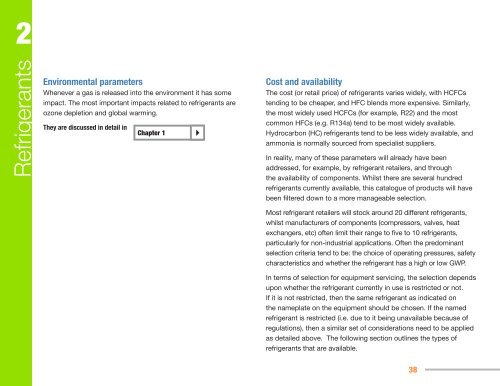Manual for Refrigeration Servicing Technicians - UNEP - Division of ...
Manual for Refrigeration Servicing Technicians - UNEP - Division of ...
Manual for Refrigeration Servicing Technicians - UNEP - Division of ...
You also want an ePaper? Increase the reach of your titles
YUMPU automatically turns print PDFs into web optimized ePapers that Google loves.
2<br />
Refrigerants<br />
Environmental parameters<br />
Whenever a gas is released into the environment it has some<br />
impact. The most important impacts related to refrigerants are<br />
ozone depletion and global warming.<br />
They are discussed in detail in<br />
Chapter 1 4<br />
Cost and availability<br />
The cost (or retail price) <strong>of</strong> refrigerants varies widely, with HCFCs<br />
tending to be cheaper, and HFC blends more expensive. Similarly,<br />
the most widely used HCFCs (<strong>for</strong> example, R22) and the most<br />
common HFCs (e.g. R134a) tend to be most widely available.<br />
Hydrocarbon (HC) refrigerants tend to be less widely available, and<br />
ammonia is normally sourced from specialist suppliers.<br />
In reality, many <strong>of</strong> these parameters will already have been<br />
addressed, <strong>for</strong> example, by refrigerant retailers, and through<br />
the availability <strong>of</strong> components. Whilst there are several hundred<br />
refrigerants currently available, this catalogue <strong>of</strong> products will have<br />
been filtered down to a more manageable selection.<br />
Most refrigerant retailers will stock around 20 different refrigerants,<br />
whilst manufacturers <strong>of</strong> components (compressors, valves, heat<br />
exchangers, etc) <strong>of</strong>ten limit their range to five to 10 refrigerants,<br />
particularly <strong>for</strong> non-industrial applications. Often the predominant<br />
selection criteria tend to be: the choice <strong>of</strong> operating pressures, safety<br />
characteristics and whether the refrigerant has a high or low GWP.<br />
In terms <strong>of</strong> selection <strong>for</strong> equipment servicing, the selection depends<br />
upon whether the refrigerant currently in use is restricted or not.<br />
If it is not restricted, then the same refrigerant as indicated on<br />
the nameplate on the equipment should be chosen. If the named<br />
refrigerant is restricted (i.e. due to it being unavailable because <strong>of</strong><br />
regulations), then a similar set <strong>of</strong> considerations need to be applied<br />
as detailed above. The following section outlines the types <strong>of</strong><br />
refrigerants that are available.<br />
38

















